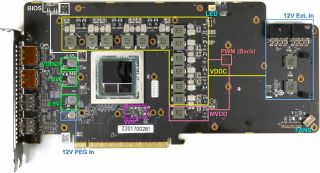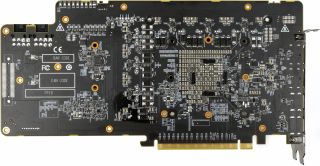PowerColor Red Devil RX Vega 64 8GB HBM2 Review: Cooling Vega Right
Why you can trust Tom's Hardware
Board & Power Supply
Board Layout
PowerColor's layout may seem a little different from AMD's reference PCB at first glance. However, the most important areas carry over almost 1:1. The second BIOS, lighting connector, and switches cause the board to be extended upwards a bit.
This implementation employs six power phases with doubling, resulting in 12 voltage converters for the VDDC and one phase for the memory (MVDD), just like AMD. In terms of components, PowerColor mostly mimics the AMD design.
The sources of other auxiliary voltages are also visible in our layout diagram.

Aside from the densely populated area opposite the GPU package, we also find the PWM controller, phase doublers, and SMD capacitors on the board's back side.

PowerColor employs a pair of eight-pin connectors to complement the PCIe slot's power delivery. Since our measurements show the motherboard slot only feeding this card 23-26W, those two connectors handle the rest.
GPU Power Supply (VDDC)
As with AMD's reference design, the focus is on International Rectifier's IR35217, a dual-output multi-phase controller that provides six phases for the GPU and an additional phase for the memory. But again, there are 12 regulator circuits, not just six. This is a result of doubling, allowing the load from each phase to be distributed between two regulator circuits.


A total of six International Rectifier IR3598 multipliers on the back of the board are used to double the controller's phase count. Our infrared thermal measurements make it easy to see how the PWM controller shifts load back and forth between individual phases at idle to maximize efficiency, but also avoid overloading any one specific circuit.
Voltage conversion of the 12 circuits is performed by an International Rectifier IRF6811 on the high side and an IRF6894 on the low side, which also contains the required Schottky diode.


For the resonant filters in the VDDC, PowerColor relies on 190nH encapsulated ferrite coils, similar to AMD's reference card. The capping of extreme spikes on both external 12V supply connections is achieved through generous 560nH coils.


Memory Power Supply (MVDD)
As mentioned, the memory's power is controlled by International Rectifier's IR35217 as well. One phase is fully sufficient for this card, as its HBM2 is less demanding. A CHL815 gate driver is placed on the board's back, while a NTMFD4C85N dual N-channel MOSFET on the front is used for voltage regulation. The co-packaged solution includes both high and low sides.


It’s interesting that PowerColor uses SMD capacitors instead of can caps. Their somewhat lower capacity is compensated for by simply running two of them in parallel on the back of the board. It does make sense to spread the hot-spots and make the thermal solution's job a little easier. Waste heat is kept to a minimum, as is the cost associated with cooling.
At 220nH, the coils are a bit larger this time around. The ones corresponding to the "partial voltage" converters, which operate at a much lower frequency, are even larger at 820nH. They don’t have to deal with the same amounts of power, though.
Additional Voltage Converters
Creating the VDDCI isn’t a very difficult task. But it's an important one since this regulates the transition between the internal GPU and memory signal levels. It’s essentially the I/O bus voltage between the GPU and memory. A constant source for 0.9V is generated as well, along with a 1.8V source (TTL, GPU GPIO). These three voltage converters are equipped almost identically, relying on an MPS MPQ8633 synchronous step-down converter.
Underneath the GPU, there’s an Anpec APL5620 low drop-out linear regulator, which provides the very low voltage for the phase locked loop (PLL) area.
PowerColor places a switch up top to control its dual-BIOS functionality. The second chip is placed right next to that switch in the PCB's extended upper area.


ON Semiconductor's MC74HC238A demultiplexer drives the LED bar that shows the power supply’s load. It’s a fun gimmick, but does get annoying in a dark room at night due to its brightness. Fortunately, there's another switch you can use to turn the lights off entirely.


MORE: Best Graphics Cards
MORE: Desktop GPU Performance Hierarchy Table
MORE: All Graphics Content
Current page: Board & Power Supply
Prev Page Features & Specifications Next Page Gaming Benchmarks At 2560x1440Stay on the Cutting Edge
Join the experts who read Tom's Hardware for the inside track on enthusiast PC tech news — and have for over 25 years. We'll send breaking news and in-depth reviews of CPUs, GPUs, AI, maker hardware and more straight to your inbox.
-
Gillerer I wouldn't trust PowerColor's quality control.Reply
My old HD 5850 came with an "Engineering Sample" BIOS with no officially supported way of updating it. -
10tacle Nice to still see some AMD high end GPU reviews on Tom's. Well done. Unfortunately, this review continues to prove that AMD is well behind Nvidia in the upper tier GPU segment when it comes to gaming bang for the buck. AMD just doesn't have the R&D pockets that Nvidia does because they have shifted focus to CPU/APU production. I would love to see an AMD competitor to Nvidia's GTX x80 Ti high end GPU. Their last stab at it was with the Fury X against the 980 Ti which fell as flat as Bulldozer.Reply -
davidgirgis "We have a hard time recommending..." -Igor WallossekReply
However...
"9/10" and "Editor's Choice"
"Been dazed and confused for so long it's not true" -Robert Plant -
redgarl Reply21026800 said:Nice to still see some AMD high end GPU reviews on Tom's. Well done. Unfortunately, this review continues to prove that AMD is well behind Nvidia in the upper tier GPU segment when it comes to gaming bang for the buck. AMD just doesn't have the R&D pockets that Nvidia does because they have shifted focus to CPU/APU production. I would love to see an AMD competitor to Nvidia's GTX x80 Ti high end GPU. Their last stab at it was with the Fury X against the 980 Ti which fell as flat as Bulldozer.
It is the use of HBM 2 and the shortage that skyrocket the price of this card. The Vega 64, unfortunately, is a mining card. With proper undervolting and tweaks, it performs really well, unfortunately, for gaming at this price you better getting a TI. Still, if the price was about the same as a 1080, I would grab a Vega instead. -
eric.m.hudson1 "I wouldn't trust PowerColor's quality control.Reply
My old HD 5850 came with an "Engineering Sample" BIOS with no officially supported way of updating it."
That's a long time to hold a grudge. I've had 2 PowerColor 290x's and Red Devil RX 480 and 580 cards. All of them were great performers and had better cooling than the majority of the competition. Also, they were all unlocked/dual bios cards. I like what PowerColor does with AMD cards. -
Rogue Leader Card sounds great, looks awesome, but the price is double what its worth (and I say that as someone who owns a Liquid cooled Vega 64).Reply -
Rogue Leader Reply21027991 said:https://i.imgur.com/BfZBaTL.jpg
Was $1100 US this morning, now a more reasonable $719. Still here in the US a GTX 1080 can be had for $120 cheaper minimum and performs basically the same. However at the price where you are its totally reasonable. -
TJ Hooker Reply
You should really include the context for that first quote:21026820 said:"We have a hard time recommending..." -Igor Wallossek
However...
"9/10" and "Editor's Choice"
"But even though it's generally faster than GeForce GTX 1080, Nvidia's closest competitor is currently available at a $200+ savings. We have a hard time recommending any Radeon RX Vega 64 with such a chasm between boards best suited to 2560x1440 gaming."
A GTX 1080 and Vega 64 have the same MSRP, but he's saying the fact that the Vega is selling for $200 more makes it hard to recommend. Although in reality the price difference is much lower in many places.
Edit:
The price delta between the cheapest 1080 and Vega 64 on PCpartpicker US is $30 right now ($70 for red devil specifically). On Newegg.com that expands to $50 and $90, but only because that includes a dinky single fan 1080 that's $20 cheaper.21028036 said:Was $1100 US this morning, now a more reasonable $719. Still here in the US a GTX 1080 can be had for $120 cheaper minimum and performs basically the same. However at the price where you are its totally reasonable. -
hurnii Re: "Semi-passive" cooling mode not working:Reply
My Red Devil's BIOS switch has 3 positions:
Max OC (fairly useless)
Middle Position ("Normal ?")
Semi-Passive Mode
When switching BIOS, the Computer needs to be turned off, the switch set to the desired position, then Computer PSU turned back on.
For my card, if I turn the computer Off, set the BIOS switch position to semi-passive, and then turn the computer on, the fan stays off (passive mode) while the OS boots up.
In fact, when I first installed the card, the switch was already in semi-passive mode, so when the computer booted up initially, no fans spun. Had to shutdown, flip the switch, and power back up. That time, the fans did spin.